I start my first boat trip with a 10+ hour, 2-day cruise in the Seattle area.
In my last blog post, I wrote a little about closing on my new boat, naming it, and planning its first trip. On September 6 and 7, 2022, I made that trip. I’ll tell you a little about it here; let’s see how brief I can be.
Cruising with Larry
Imagine this: you’ve just spent a relatively large amount of money on a 33 foot (length over all; LOA) trawler with a 300 horsepower diesel engine, bow and stern side thrusters, three chart plotters, auto pilot, sonar, radar, VHF radio, and everything you need to cruise long-term on fresh or salt water pretty much anywhere in the world. You’ve stepped up to this boat from a 17 foot jet boat and your only other boating experience is perhaps a total of 100 days in motorboats, house boats, and a pair of cabin cruisers similar to the one you’ve just acquired. Would you take it out by yourself on a 120-mile journey in relatively unfamiliar tidal waters?
Well, you might, but I wouldn’t. I hired an experienced boat captain to cruise with me the first day.
His name is Larry and he came recommeded to me by another Ranger Tugs captain who was unable to meet with me on the date I needed him. I met up with him at the Edmonds WA ferry terminal parking lot. That was after making the 3-hour journey from Malaga, which began at 5 AM. From there, we headed on a roughly 2-hour drive through Seattle to Olympia where the boat lived in a covered slip.
We talked boats during that time. He had a good amount of experience on a variety of boats but didn’t know Ranger Tugs quite as much as I wished he did. It wasn’t the driving that concerned me — most boats this size drive pretty much the same way. It was the boat’s other systems I needed schooling in. But that didn’t really matter at that point. The most important thing was getting the boat started on what would be a two-day journey from Olympia to Roche Harbor on San Juan Island.
But first we needed to stop in downtown Olympia at the boat broker’s office to pick up the keys and a box of spare parts for the boat.
Then, at the marina, I needed to fill in some paperwork and get an electronic key for the dock gate. And a parking pass for the parking lot.
And then we needed to move a truckload (literally) of boxes, bins, luggage, and bags of stuff from the truck to the boat.
This is where things got screwy. We didn’t have time to offload all those boxes and put the empties back in the truck. All we could do was fill the rear deck and sleeping area and dining area with boxes and bags and luggage. It was noon by the time we were ready to go and we couldn’t wait any longer. We had 50 miles to cover in a boat that might cruise as slowly as 10 knots — neither of us knew.



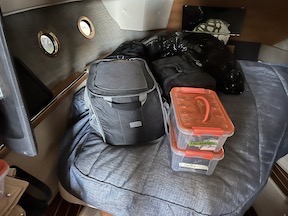
I couldn’t unpack, so I just put the boxes, bins, luggage, and cooler wherever I could fit them.
I learned how to check fluid levels and a handful of other things in the engine compartment and start the engine. Larry cast us off and guided me as I backed the boat out of its slip, used the thrusters to pivot nearly 180°, and pull out of the marina.
It was remarkably easy. The secret is to not be in a rush. At all.
Of course, having a nearly windless, currentless departure with no other traffic helped.
We didn’t have time to plot our course on the Garmin chart plotters, but I’d plotted it on my iPad using Aqua Map. Larry had his iPad and Navionics. We weren’t going to get lost as we wound our way between the islands in South Puget Sound, under the Tacoma Narrows Bridge, and eventually past Seattle.
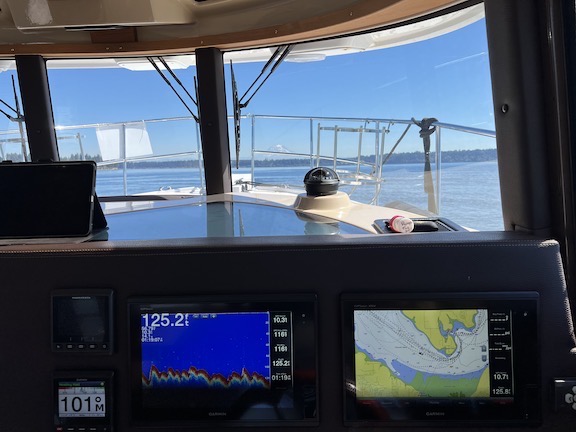
Underway just out of the marina. If you look closely, you can see Mt Rainier.
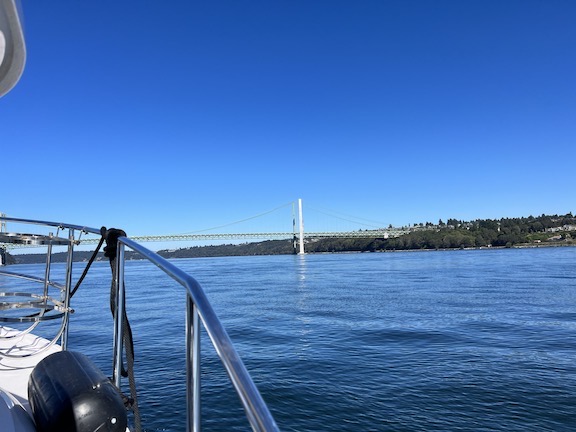
Approaching the Tacoma Narrows Bridge.
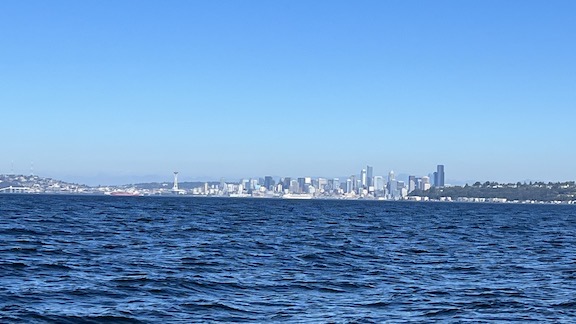
The Seattle skyline from Puget Sound.

My pups settled right into the lower berth, which was still stuffed with all kinds of equipment that needed to be properly stowed.
We started at the upper helm but, since it was cool, we decided to move to the lower helm, which is inside. There was some confusion about how to transfer the throttle control downstairs; it turned out that I hadn’t put it in neutral upstairs. (The boat has Idle Forward and Idle Reverse gears; I’d left it in Idle Forward.) Once we figured that out, we settled in downstairs, leaving the back door open. Lily and Rosie, my pups, settled into the lower berth, moving in as if it had been made for them.
The trip was uneventful. The water was remarkably calm for most of the ride and the channel was plenty wide enough that looking for buoys wasn’t a necessity. We set an RPM that gave us 10 to 12 knots. The engine sounded good. Everything worked.
Except the fuel indication on the chart plotter. It said we had 103 gallons of fuel on board, but it was blinking and didn’t change, despite the fact that we were obviously burning fuel. This bothered me but I wasn’t going to worry about it. (In hindsight, I don’t know why I didn’t worry about it; I should have. After all, how long had it been blinking 103 gallons? A year?) Near the end of the trip, Larry peeked at the gauges in the lower cabin and reported I had nothing to worry about — the gauge there said I had just over half a tank.
I drove most of the way. Larry and I chatted about various maneuvers. We had no time to stop and try anchoring or anything else. The clock was ticking and I wanted to be at Kingston before sunset.
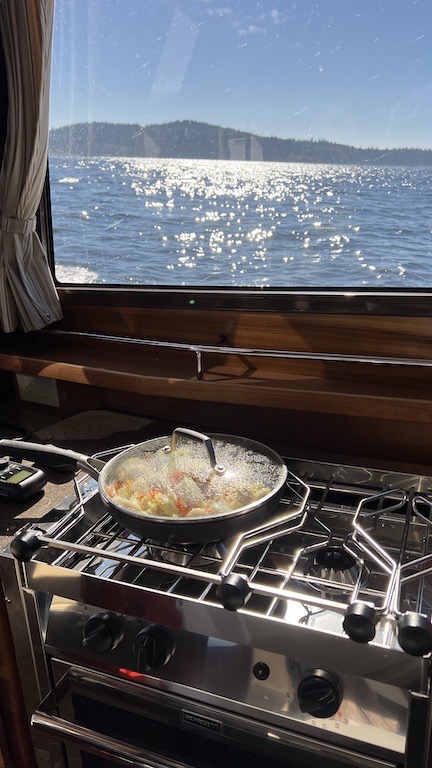
Making lunch while under way.
Around 3 PM we were both really hungry. I gave the helm to Larry and made us some lunch. On the stove. There were pot holders there so I didn’t have to worry about the pan moving, even when it got a little rough. I had to dig through all the packed boxes to find the pan, plates, and silverware. And through the cooler to find the ingredients. I’d prepped some aromatic vegetables at home the night before and cooked them up with olive oil and butter. I added some pan gnocchi. Then, when everything was almost done, I added 12 ounces of sea scallops and cooked until they were done. We took turns eating. It was just as tasty as a first meal prepared in a new boat should be.
And then we were there, just outside the Port of Kingston. A very large ferry boat was crossing from Edmonds just as we arrived. I got back on the helm — upstairs, because the visibility is just better from up there — and brought the boat in slowly, again following Larry’s instructions. There was a bit of a headwind that turned into a crosswind as I turned to go into the slip. Larry had me cruise past the slip, then use the thrusters to make a 90° pivoting turn so I was pointing into the slip. I then drove in slowly, letting the wind and then the thrusters take me gently against the dock. Larry tied us up.

We did about 60 miles the first day, from Olympia to Kingston.
Then I was hurriedly gathering together his things and my checkbook and the dogs. The ferry had docked and he wanted to be on the return run to Edmonds where his car waited. I wrote a check and sent him on his way.
Organization — and a Guest
I walked my pups and went back to the boat to start unpacking.
It was a huge chore. I had about 75% of what I’d need on board in a large cooler and various boxes, bags, and plastic bins. Once I unpacked, I still had the cooler and bins. In a perfect world, I would have had a full day to unpack everything and store the empties back in my truck. But we all know this isn’t a perfect world. Not only did I have to unpack everything and find room for it, but I also had to find room for the empties.
While all this was going on, my Twitter friend Juliana stopped by. I knew that she lived in the area and had invited her. We’d never met in person, but we’d both worked with Lynda.com in the past — I’d been an author and she’d been an editor. She brought a bottle of wine and we made room among the boxes and general mess to sit at the table and drink it. All of it. I was feeling pretty relaxed when she left.
I got the organization job about halfway done, concentrating on the important stuff — the contents of the cooler; the cookware, dinnerware, and silverware; my clothes; and the bed linens. This is when I made two discoveries: First, I’d packed a bottom sheet but not a top sheet for the bed. Second, the custom bed cover hid custom sheets.
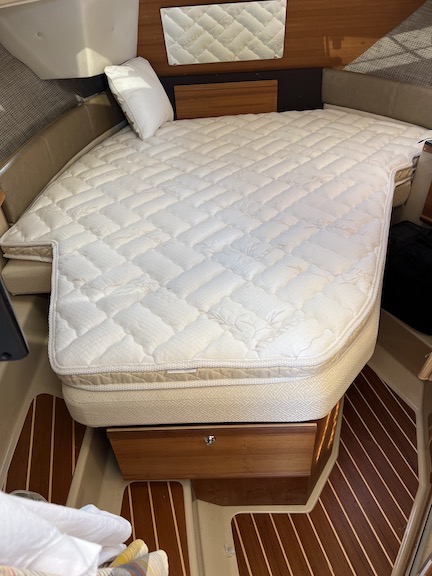
Here’s the bed’s custom mattress topper. This is the exact shape of the bed.
I should take a step back and talk a little about the bed. It’s a very odd shaped bed. Custom bedding was available for it on a website called YachtBedding.com and I’d already checked it out. But since I was not interested in spending $1200 for a set of sheets — yeah, I know I’m being a cheapskate here — I figured I’d just use two flat sheets, tuck one in all around as a bottom sheet, and deal with weird overhangs on the top sheet. If that didn’t work, I’d just cover the mattress and use a sleeping bag.
But the bed had not only the fitted bed cover, but a custom cotton blanket, a full set of those expensive sheets and, under that, a custom mattress topper. I was set!
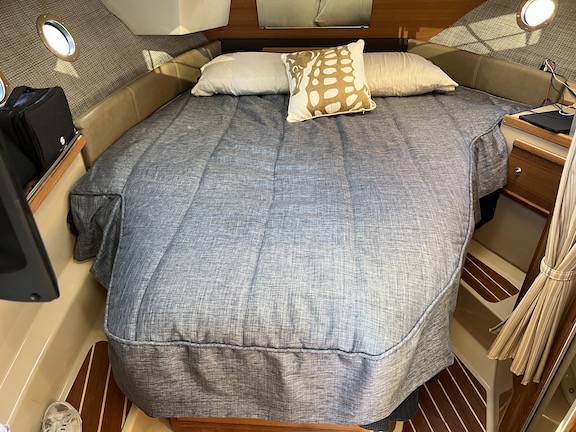
Here’s what the bed looks like fully made with the linens the boat came with. (I washed the sheets at Roche Harbor and made the bed so it would look nice.)
But not that night. I was not going to sleep on sheets that might or might not be clean. They’d need to be washed. Until then, I’d have to use what I brought: a queen sized bottom sheet with my freshly washed queen sized comforter. Fortunately, I’d also brought pillows and clean pillow cases. Needless to say, the bed looked a mess when I was done.
I think I finally turned in a little after 9 PM. The marina, which is on the other side of a rock sea wall from the ferry terminal, was surprisingly quiet. I’m used to marinas being loud places with clanking sailboat rigging, but this place was almost eerie in its silence. Even the ferry boat’s coming and going was muted.
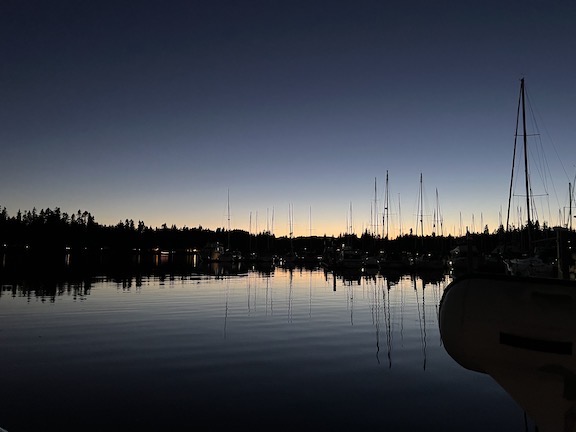
Just past sunset at the marina. Peaceful, no?
I slept like the dead.
Day Two: Going Solo
I woke at my usual time — around 5 AM — and set about making coffee. The boat was plugged into shore power so my one-cup drip coffee maker was available for use. I’d prepped it the night before so I was back in bed with a hot cup of coffee within minutes.
(And that’s a morning routine that I realize I need to change. I picked it up last year sometime — getting up early (as I usually do) and bringing my coffee back to bed with me while I catch up on Twitter, do some word puzzles, read, and/or plan my day. While it’s nice to have that relaxation time in a comfy place with my pups still sleeping beside me, it’s really cutting into the time I’d otherwise use to write or get things done. I skipped it this morning just so I could finish this blog post, which I started days ago. I think I need to stop being so darn lazy in the morning.)
When my pups woke up, I took them for a quick walk to a patch of grass just beyond the docks. Then back to the boat where I finished dressing, fed them, and kept poking around to explore my new surroundings. The lower berth was filled with things I needed to sort out: carpeting, table legs, tables, flagpole, fire extinguishers, PFDs, and other safety equipment.
I found the gauge Larry had read the day before, when he assured me I had more than half a tank of fuel left. It was labeled Water. So yeah: I had no idea how much fuel was on board.
By this time, it was nearly 7 and I took my pups out for a proper walk. There was a crepes restaurant on the corner and I waited patiently for it to open so I could buy a breakfast crepe and bring it back to the boat. It was huge but admittedly not very good. I ate half. Then I finished securing everything that needed securing inside. The sailboat that was parked at the fuel dock pulled away. It was time for me to pull out of my slip and dock for fuel. By myself.
Again, slow and steady is the way. There’s no reason to rush and the conditions, once again, were perfect. No wind, no current. I turned on all of my instruments and started the engine. Then I went out on the dock and untied the boat, leaving the aft midship line for last. The boat barely moved. I climbed aboard, went up to the command bridge, transferred the controls to that helm, and slowly backed out. Once I cleared the boat on my port side, I used the bow thruster to bring the front of the boat around to port. (I should mention here that because of the position of the rudder on this inboard engine powered boat, steering has no effect in reverse, although “prop walk” does tend to bring the stern to port a tad.)
I have to say that I impressed myself — and I am my toughest critic. I’d visualized my approach to the fuel dock and I think that helped a lot. I just eased over there and set the boat beside the dock, getting it to a complete standstill before the dockhand could grab a line.

My first fill-up. OUCH.
A while later, I was pumping diesel into the tank port. It was a thirsty puppy and took 92 gallons. (If you figure I have a 145 gallon tank, that means I only had 53 gallons on board — not 103 gallons or more than half a tank. It would have been enough to get me to my destination, but what if it hadn’t been? Better safe than sorry, no? And yes, I’ve since discovered not one but two fuel indicators; more on that in another blog post.) While filling up, I learned that the glug-glug sound near the end means to stop fueling now. I also learned how diesel fuel spill rags can soak up oil but not water.
While I was chatting with the dockhand, the subject of lines came up and I told him I didn’t think I had enough. Did they sell them in the office? He told me that they had a bunch of lines that they were giving away. I had my doubts, but followed him to a storage building and was rewarded with three brand new ropes, still in their packaging. “Defective” he said, but neither of us could find anything wrong with them.
I paid for the fuel, prepped the boat for departure again, and cast off. I made a graceful (i.e., slow motion) departure from the dock, using the throttle and my thrusters to get the boat turned around. Then I left the marina at idle forward thrust, which gave me about 3 1/2 knots. It was low tide and not difficult to see why staying in the channel was important — beyond it were what I’d call mud flats. Then I was out beyond the sea wall, slowing to let the ferry depart ahead of me, and then picking up speed to start my trip north.
And this is where I made my first error: when I came away from the marina and was in open water beyond the ferry path, I should have brought the boat to idle and retrieved my fenders. Instead, I let them “fly” for the entire trip to Roche Harbor. No harm done, but not good for the lines, the fenders, or the side of the boat. What’s crazy is that I had to drop down to idle anyway to come from the upstairs helm, which was chilly, to the more comfortable inside helm. Why didn’t I do it then? No idea, but I won’t make that mistake again.
The conditions started off very good, with smooth water as I headed northwest along Whidbey Island’s west shore. There was a ship channel that was well marked and I did pass one inbound ship along the way. I got to play with the AIS feature on my chart plotters.
AIS or Automatic Identification System is like ADS-B is for aircraft — a system that broadcasts and/or receives vessel information including name, position, speed, etc. What’s odd is that in the aviation world, ADS-B Out is required for all aircraft while AIS transmit is only required for commercial ships. And while ADS-B In is not required or even used on most general aviation aircraft, AIS Receive is widely available on boats with chart plotters. My boat, it turns out, receives AIS signals but does not transmit them. That means I can learn about at least half the boats I’ve seen in my travels but remain invisible to them. This is something that’ll cost about $1000 to “fix” by adding a Garmin AIS Blackbox Transceiver to transmit my signal. I’m not sure yet whether I want to make this investment.
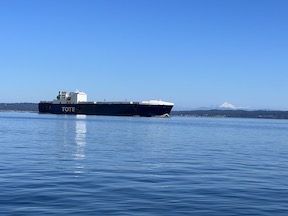

I can see a ship and tap an icon on my chart plotter to learn more about it, including its name and speed.
While Admiralty Inlet wasn’t rough at first, the farther north I got the rougher the water got. It didn’t help that the current was against me, slowing me down. I’d been traveling with the RPM set at 2600, but when speed dropped below 10 knots, I upped it to 2700 and, later 2800. That got me more than 10 knots and, at times, up to 12. By the time I got into the Strait of Juan de Fuca, I was cutting through choppy waves, rolling, and getting splashed good enough to run my windshield wipers. My pups were not happy and I wound up putting them both on the bench seat beside me.
It was a 19 mile stretch across the strait with only the tiny Smith Island in the middle of it. I don’t know if I imagined it, but it seemed that the water calmed a little once I’d passed that island. The current changed, too, and was soon in my favor. It was pretty much rolling through the gap between Lopez and San Juan Islands, spitting me out into the San Juan Channel with SOG (speed over ground) in excess of 15 knots.
There was a lot of debris in the water as I continued up the channel, taking the wheel to steer around logs, sticks, and rafts of weeds big enough to hold sea birds. (Enroute, I normally use the autopilot’s Heading Hold feature to set a course that I can occasionally adjust with a push of a button, but when there’s serious steering to do, I take the wheel.) The minutes and miles ticked away. The water was calmer among the islands and it was more pleasant traveling.
I started seeing other Ranger Tugs going my way when I reached Spieden Island. I had been warmed to take the far pass into Roche Harbor, staying west of Pearl Island, so that’s what I did. Although I think I could have cleared the skinny water on the east side — my boat’s draft is only 2 1/2 feet — why take a chance? I discovered later in the week that a 43-foot Ranger Tug had gone the other way and had severely damaged one of its two pod engines.
Arriving at the Rendezvous
The purpose of the trip had been to attend the annual Ranger Tugs/Cutwater Rendezvous, which was the first held in more than two years (because of Covid). It was a huge event at Roche Harbor Resort and Marina which would eventually gather together more than 200 boats made by the same folks who made mine. There would be seminars and get togethers and a lot of fun — all of which I’d cover in another blog post.
For now, all I cared about was getting my boat into a slip.
The radio guidance was more like dealing with an air traffic controller than I’d likely ever experience again at a marina. One by one, a man apparently at the marina headquarters assigned slips to incoming boats and provided instructions on how to reach them. When it was my turn, I didn’t like his instructions at all. He wanted me to rig the boat to back into the dock. That meant removing my dinghy and bicycle and putting fenders back there. He didn’t seem to care that I was on board by myself and would have to reconfigure my setup while trying to prevent my boat from drifting into other traffic.
I tried. I really did. I got the dinghy down and on a rope tied behind me. And then I started struggling with my bicycle, which I’d fastened to the rails on the swim platform. And I said to myself, fuck no. I’m not dealing with this.
I went up to the command bridge, got on the radio, and told him I was by myself, I had too much to move around, and I just wanted a bow in starboard tie. Anywhere.
He sounded annoyed and told me to wait. Then he got back on and sent me to a slip on J dock. I was disappointed because I knew that’s not where everyone else was parking. I was being sent to the hinterlands because I didn’t want to back my boat into a slip on my second solo attempt to tock. (I’m counting the fuel dock here.) He assured me that other Ranger Tugs would be there.
By that point, I just didn’t care. I motored over to J dock where a dockhand waited to help me park. It wasn’t as smooth as my fuel dock parking job — possibly because I was pissed off and tired and people were watching — but I didn’t embarrass myself.
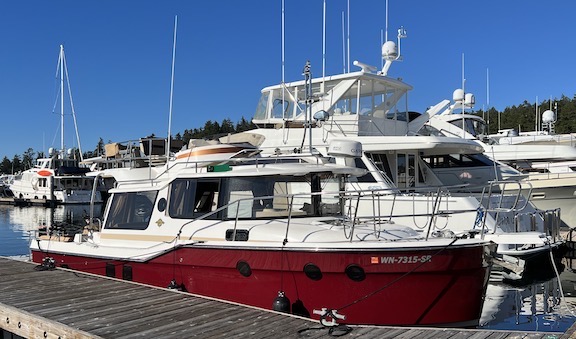
Do It Now docked at Roche Harbor.
I was very happy to shut down the engine. It had been a long day.
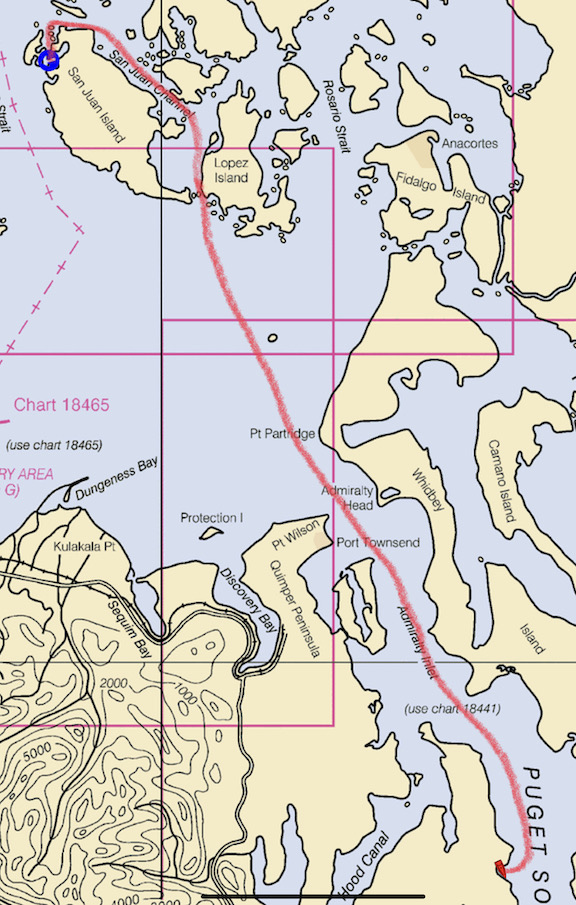
My first solo cruise was about 50 miles from Kingston to Roche Harbor.
You can read about the Rendezvous I went to Roche Harbor to attend in another blog post.
Discover more from An Eclectic Mind
Subscribe to get the latest posts sent to your email.

Fascinating and honest read.
Thanks! I try to keep it real.
Good trip, good post. Way to stick to your guns. It is your boat and your responsibility.
My mistake in docking at Roche Harbor was not speaking up when he gave me the initial slip assignment. I think I was worried about being exiled away from the group — which I was — but I met some really great people on J-Dock so it all turned out for the best. Now I just need to remember to request a bow in, starboard tie whenever I reserve a slip. The power connection on the boat is on the starboard side, so it really does work best for this boat, especially with the dinghy positioned as it is on the swim platform.
I’m glad the weather was kind on your first single-handed trip. Enjoy the rest of the Ranger-Fest.
That bed is such a weird shape! Looks like you’ll be sending off for bespoke sheets for a while yet!
BTW, that diesel fill-up would have cost you $948 here in the U.K. today. Count your blessings…
Fortunately, it came with those custom sheets — they were hiding under the bedspread — and I’ll just use-wash-use-wash them until they fall apart. There’s no way I’m spending over $1000 for a set of sheets. Heck, I’m not opposed to sleeping in a sleeping bag.
I filled up twice over the past 10 days and the second fill up was 103 gallons. Ouch!
Great run, Maria(!) Not spending $1K on sheets (sewn with gold thread?) is not being cheep, it’s called being frugal. A local seamstress could no doubt make some up for you. You pic with Rainier in the distance was eye-opening to me; not much snow on top. I lived in Tacoma in the 70s; never saw it looking like that. Enjoy – “Life-is-Short” (that’s what I might call my boat, if I ever were to own one :)
I think Rainier was worse last year, but I don’t know. I know they were talking about it more last year. Life is Short is another good name.
I honestly don’t know why they charge so much for the sheets. Other than a weird shape, they shouldn’t be so expensive. They have less fabric. A pattern is a pattern and they apparently have the one for this bed. I think they’d sell a lot more sheets if the price was reasonable.